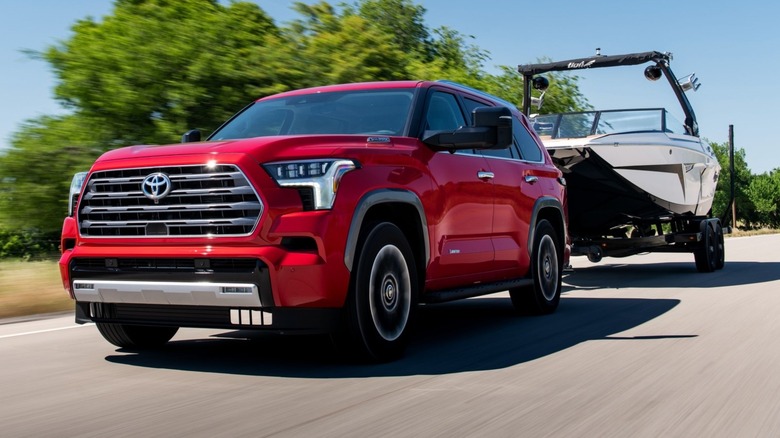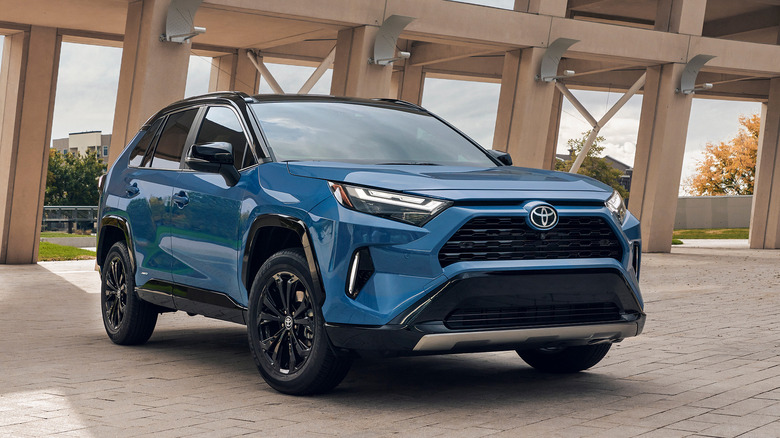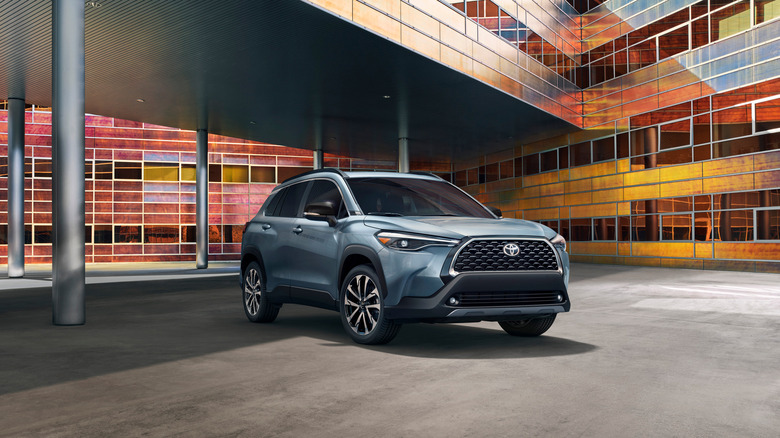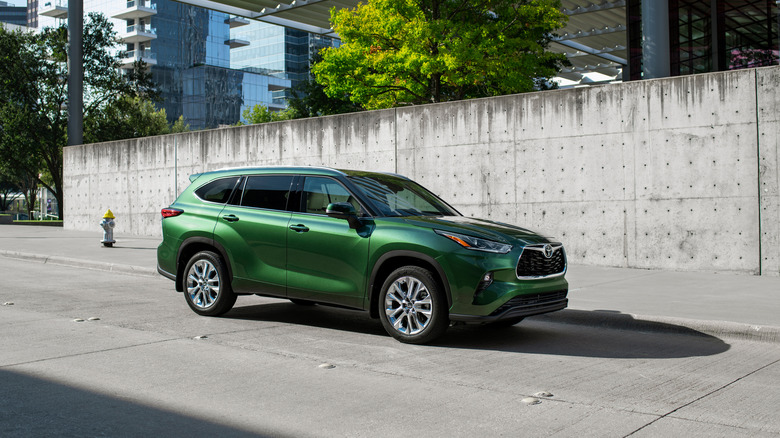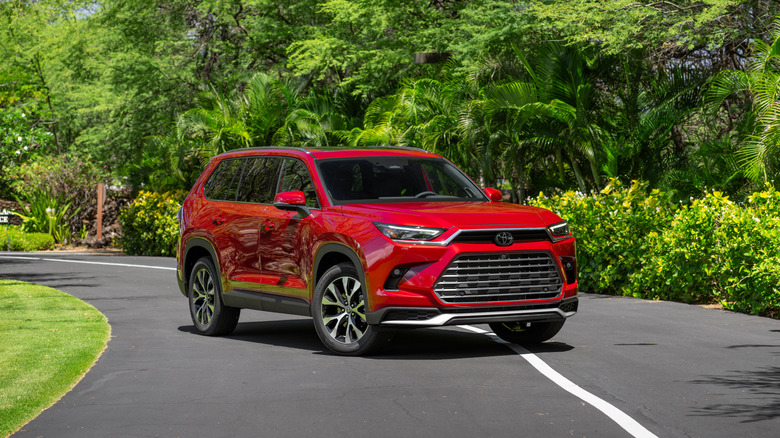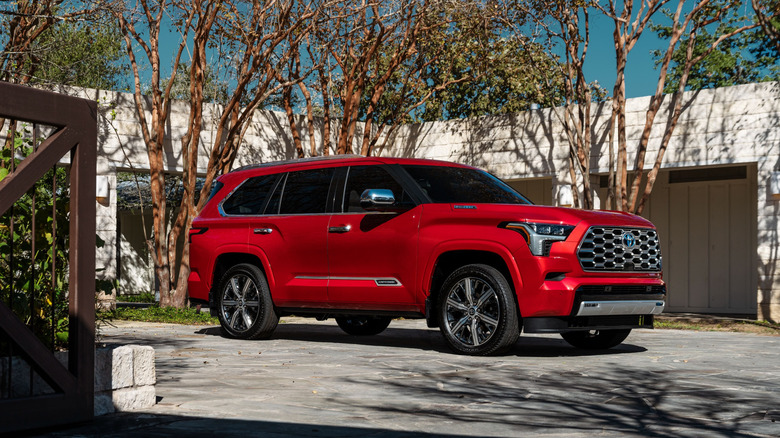Yes, Some Toyota SUVs Are Made In America - Here's Which Models Are Assembled In The US
America is currently the second biggest car-producing nation in the world. According to Statista, globally, about 93.5 million vehicles were manufactured in 2023, with car plants in the U.S. producing 10.6 million of that total. In 2022, according to USA Facts, U.S. car production stood even higher at a whopping 12.86 million vehicles. Being one of the largest automakers in the world, Toyota makes an important contribution to the U.S. production figure, with up to five of its factories churning out various car models, trucks, and SUVs.
These include the ever-busy Toyota Motor Manufacturing, Indiana, Inc. (TMMI) , Toyota Motor Manufacturing, Kentucky, Inc. (TMMK), and Toyota Motor Manufacturing, Texas, Inc. (TMMTX). Toyota Motor Manufacturing, Mississippi, Inc. (TMMMS) and Mazda Toyota Manufacturing, U.S.A., Inc. (MTM) — which began production in September 2021 — are the other Toyota vehicle production locations in the United States. These facilities produce everything from the Toyota Tundra to Corolla, Camry, Sienna, Lexus ES, and Lexus TX. As for Toyota SUVs, there are up to five models that are made in America.
RAV4 Hybrid
When the Toyota RAV4 Hybrid debuted for 2016 and became only the seventh Toyota hybrid model, production was initially completed at the company's manufacturing facilities in Japan and Canada. However, starting in 2020, the hybrid SUV has also been built by Toyota in America at its massive plant in Georgetown – Toyota Motor Manufacturing Kentucky (TMMK). TMMK stands out among Toyota plants worldwide for its over nine million square feet of floor space, which makes it the brand's largest production location.
In addition to the RAV4 Hybrid, the Kentucky facility currently builds the Lexus ES and the now hybrid-only Toyota Camry. As for the performance, the 2025 Toyota RAV4 Hybrid comes standard with a 2.5-liter four-cylinder engine, which is used in conjunction with two electric motors to deliver standard all-wheel drive along with a combined 219 horsepower and 252 lb-ft of torque. With that, you can achieve an average fuel economy of 39 MPG, though the RAV4 Hybrid Woodland Edition is less economical but earns a still impressive 37 MPG, according to EPA estimates. For context, the most efficient non-hybrid RAV4 model returns 30 MPG in combined city and highway driving.
Toyota Corolla Cross and Corolla Cross Hybrid
An SUV variant of the Corolla, the Toyota Corolla Cross is a city-friendly SUV that's based off the brand's GA-C platform, which is shared with the Toyota Corolla, CH-R, and the Lexus UX. It is the smallest and cheapest Toyota SUV you can currently buy new, with prices starting at $24,135 for the gasoline model and $28,495 for the Corolla Cross Hybrid – both before a $1,350 destination fee is included.
The low-cost compact SUV has been around since the 2022 model year and is assembled at the Mazda Toyota Manufacturing plant in Huntsville, Alabama – a joint venture between Mazda and Toyota that can produce as many as 300,000 cars each year. Performance-wise, the gas model comes with a 2.0-liter four-cylinder engine producing 169 horsepower and 151 lb-ft of torque, whereas the hybrid variant has a 2.0-liter four-cylinder gasoline engine twinned with three electric motors to deliver 196 combined horsepower and 139 lb-ft of torque. In regards to fuel economy, the Corolla Cross Hybrid averages 42 MPG, while the gas version is good for up to 32 MPG.
Toyota Highlander and Highlander Hybrid
Since its debut in 2000 as a midsize crossover SUV based on the Lexus RX 300 platform, the Highlander has been an astounding success for Toyota. It has sold around 3.6 million units in the U.S. alone and continues to catch the attention of new car shoppers thanks to its good fuel economy, comfortable interior, and useful cargo space. Early examples of the SUV were made at the brand's Toyota Motor Kyushu manufacturing facility in Fukuoka, Japan, but production for the North American market was moved to Toyota Motor Manufacturing, Indiana (TMMI) in October 2009 ahead of the 2010 model year.
Fast forward a few years, and the Princeton plant saw the addition of the Highlander Hybrid in 2013. The current Toyota Highlander is offered in five trim levels, namely the LE, XLE, XSE, Limited, and Platinum. Irrespective of trim, the Highlander uses a turbocharged 2.4-liter four-cylinder engine that puts out 265 horsepower and 310 lb-ft of torque, sent to the front or all four wheels via an eight-speed automatic transmission. If you're more drawn to the hybrid model, it is available in XLE, Limited, Nightshade Edition, and Platinum grades, each having a 2.5-liter four-cylinder engine paired with three electric motors to produce a combined 243 horsepower. All hybrid versions of the Highlander have all-wheel drive and a continuously variable automatic (CVT).
Toyota Grand Highlander
The Toyota Grand Highlander was first launched in 2023 ahead of the 2024 model year as a midsize SUV with a roomier third row than the standard Highlander. It offers a substantial 33.5 inches of third row legroom, compared to just 28 inches for the regular Highlander. Third row passengers also get slightly more headroom at 37.2 inches versus 36.1 for the Highlander.
Cargo space is notably more generous in the Grand Highlander, too. With all seats in use, you get 20.6 cubic feet of room, which increases to 57.9 cubic feet if you fold down the third row. That can further extend to an impressively massive 97.5 cubic feet if you fold away the third and second rows. The Highlander, for its part, provides 16 cubic feet with all seats in place, 48.4 cu ft with the rearmost seats down, and a maximum of 84.3 cu ft when the third and second rows are folded.
There's plenty the Grand Highlander and Highlander have in common, however. These include the TNGA-K platform, their base powertrains, and the fact that they are both built at the 4.5 million sq ft Toyota Motor Manufacturing Indiana plant alongside the Toyota Sienna and Lexus TX. In terms of cost, the Grand Highlander is the more expensive of the two, with the base trim costing from $40,860, while the entry-level Highlander model begins at $39,820.
Toyota Sequoia
Finally, Toyota's biggest SUV, the Sequoia is another one of the models assembled in America. Toyota Motor Manufacturing Indiana was its first production site, and it was responsible for every Sequoia from its introduction in 2000 right up until 2022 when Toyota shifted the entire assembly work for the full-size SUV to the Texas plant as part of plans to produce all related vehicles together in one facility — in this case the Tundra and Sequoia.
Like the much-admired Tundra, the current Toyota Sequoia was moved to the brand's body-on-frame GA-F platform, and Toyota also got rid of the independent rear suspension found on the second-gen model, swapping it for a solid rear axle. In regard to performance, the standard method of propulsion is a hybrid powertrain, which is a version of the twin-turbo 3.4-liter V6 the Tundra uses. It's paired with an electric motor to produce 437 horsepower and 583 lb-ft of torque, directed to the wheels via a 10-speed automatic transmission.
